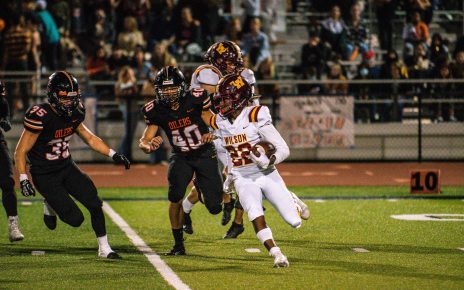When CIF Southern Section commissioner Rob Wigod was an assistant football coach at Lakewood High, the playoff format bothered him. He felt like the Lancers were a good football team with good athletes and strong coaching–but because they were in the Moore League with Long Beach Poly, Lakewood was staked to the Division 1 playoffs, where the Jackrabbits competed.
“Our kids would have done anything for the chance to win a playoff game,” said Wigod. Year after year, though, the non-Poly local teams in Division 1 got blown out. “You could just see it in our guys at the end of the year, ‘We gotta play who?’”
It’s a story Wigod has told a few times before, but this time he was talking about those players while on the field at John Ford Stadium on Saturday night, as Lakewood was hosting Northwood for the CIF-SS Division 8 title.
At the time, Wigod dreamed of a playoff format that would “give everyone a shot,” he said. “Not a guarantee, but a shot.”
That’s exactly what the competitive equity format has done over the last two years on his watch, moving teams up and down in Division at the end of the season. The goal was to match teams up with opponents of approximately their same quality, using the complex CalPreps rating system, which ranks teams from best to worst and allows the CIF-SS to assemble playoff divisions of competitive opponents each year.
Two years in, there’s no doubt that the format has been an absolute goldmine for the Moore League. After two seasons of competitive equity, four of the Moore League’s seven teams have played in a CIF-SS championship game, with Poly winning Division 4 last year before getting the bump up to Division 1 this year.
It’s hard to overstate how historic that is. Compton hadn’t played in a championship game in more than 40 years, Jordan had never competed in one, and Lakewood played in their first championship game in 52 seasons on Saturday. It’s worth noting that from 1994 until 2007, the league had a grand total of one playoff win that wasn’t by Poly--now it’s expected that teams will win a game or two against equal competition.
The playoff format certainly isn’t perfect. I heard a lot of griping from Poly’s Division 4 opponents last year that they didn’t think they were matched up with a competitive opponent. Given that the Jackrabbits ended up as a top ten team in the state this year with largely the same roster, that’s an understandable complaint.
The biggest thing for the CIF-SS to figure out is what to do with the very top of Division 1: St. John Bosco and Mater Dei. I was at the Rose Bowl to see an incredible game between those two teams, with Bosco winning 24-22 in a thriller on a stopped two-point conversion. The Braves and Monarchs this season--and much of the last decade--are the teams that the CIF-SS can’t find much competition for. The Braves and Monarchs have met in the top-flight championship game five of the last six years.
Consider that Los Alamitos beat Poly 52-42 in a great matchup that featured multiple All-Americans in the Division 1 quarterfinals this year. Los Al then got hammered by Mater Dei 52-0 in the semis. The four Division 1 games that didn’t involve SJB or MD were decided by 21 points. The four games that SJB and MD played against the rest of the field saw them win by 162 points.
What’s the answer there? I’ve heard plenty of people calling for the top two teams to simply get paired off for a championship game. The problem is it removes the ability for a team to pull off an upset, as Servite did last year in the semis. It also takes three playoff games off the board for the top two teams in the country, which I can’t imagine Bosco coach Jason Negro or whoever takes over at Mater Dei being very happy with.
This is the fun of high school sports. The playoff format is a living, evolving entity with winners and losers no matter how it’s re-jiggered and re-shaped. For now, Long Beach football fans should be happy to see their schools coming out on top, with five football championship games in two years for the first time ever.





